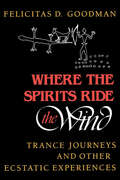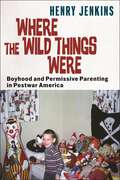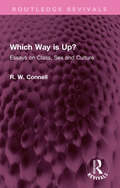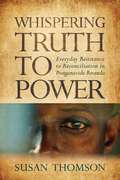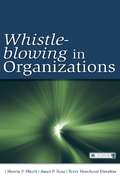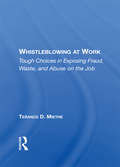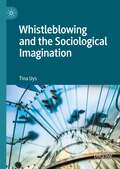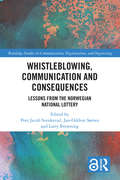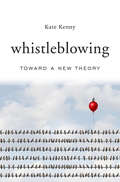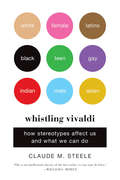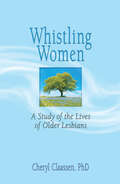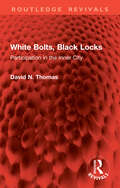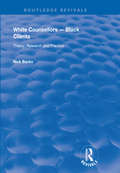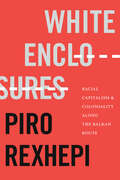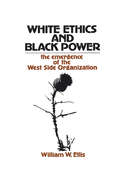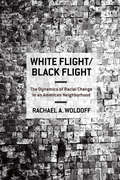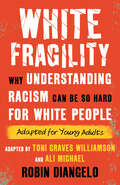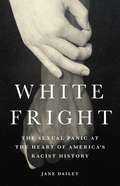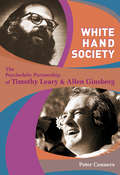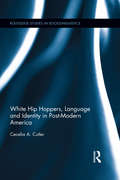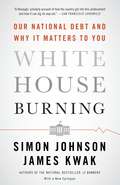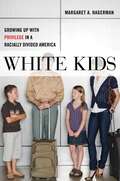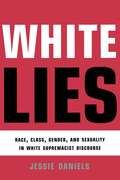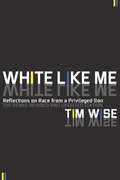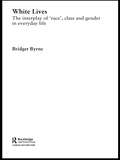- Table View
- List View
Where the Spirits Ride the Wind: Trance Journeys and Other Ecstatic Experiences
by Felicitas D. Goodman“Dr. Goodman has pioneered in the study of bodily postures and altered states of consciousness.” —Stanley Krippner, professor of personal mythology and parapsychology“And suddenly the understanding of my own vision washed over me like a mighty wave . . . For life or for death, I was committed to that mighty realm of which I was shown a brief reminder, the world where all was forever motion and emergence, that realm where the spirits ride the wind.” —from the PrologueAnthropologist and spiritual explorer Felicitas Goodman reexamines our notions of the nature of reality by studying the ritual postures of native art assumed by her subjects during trance states. For readers desiring to discover this world of ancient myths, she has included a practical guide on how to achieve such ecstatic experiences.“The book is clearly written for the general reader and includes many descriptions of trance experiences. It may serve as a good introduction to the nature and appeal of the shamanic revival in modern Western cultures.” —Theological Book Review“A case study in experiential anthropology that offers a unique mix of autobiography, mythology, experiential research, and archaeological data to support a challenging thesis—that certain body postures may help induce specific trance states.” —Shaman’s Drum“This is a spellbinding and exceptionally readable book by an extraordinary woman.” —Yoga Journal
Where the Wild Things Were: Boyhood and Permissive Parenting in Postwar America (Postmillennial Pop)
by Henry JenkinsExplores iconic works from The Cat in the Hat to The Twilight Zone to explain cultural trends in parenting and how we conceptualize childhoodThe 60s produced a Baby Boom generation that catalyzed the dawn of a new era—the space age, the age of television, the global age, and the beginnings of civil rights. At the same time, a new paradigm for parenting was unfolding that put emphasis on permissiveness, defined by what it permitted – the free and unfettered impulses of children. Others worried that the wildness of children, personified by the characters in Maurice Sendak’s 1963 classic children’s book, Where the Wild Things Are, was destructive, disruptive and disrespectful.Where the Wild Things Were centers on the exploding, contentious national conversation about the nature of childhood and parenting in the postwar US emblematized by Dr. Spock’s Baby and Child Care. Renowned scholar Henry Jenkins demonstrates that the language that shaped a growing field of advice literature for parents also informed the period’s fictions—in film, television, comics, children’s books, and elsewhere—produced for and consumed by children. In particular, Jenkins demonstrates, the era’s emblematic child was the boy in the striped shirt: white, male, suburban, middle class, Christian, and above all, American. Weaving together intellectual histories and popular texts, Jenkins shows how boy protagonists became embodiments of permissive child rearing, as well as the social ideals and contradictions that permissiveness entailed. From Peanuts comic strips and TV specials to The Cat in the Hat, Dennis the Menace, and Jonny Quest, the book reveals how childhood and the stories about it became central to Cold War concerns with democracy, citizenship, globalization, the space race, science, race relations, gender, and sexuality. Written by a former boy in a striped shirt, Where the Wild Things Were explores iconic works, from Mary Poppins to Lost in Space, contextualizing them through a critical but respectful engagement with the core animating ideas of the permissive imagination.
Which Way is Up?: Essays on Class, Sex and Culture (Routledge Revivals)
by R. W. ConnellFirst published in 1983 Which Way is Up presents a selection of Bob Connell’s writings on three key issues of modern social analysis- sex and gender, class and power, and culture. The essays range from psychoanalysis and contemporary feminism to the role theory, from the analysis of class and culture to the debate about intellectuals and the ‘new class’. In critically reviewing contemporary thought on these issues, the author has developed a perspective centred on the analysis of social practice. Easy to read, often witty, the essays represent an attempt to shift social theory into the real world of the late twentieth century, to go beyond the limits of orthodox sociology and radical dogmas, to think through theoretical questions without losing touch with practical politics. This is a must read for students and scholars of sociology.
Whispering Truth to Power
by Susan ThomsonFor 100 days in 1994, genocide engulfed Rwanda. Since then, many in the international community have praised the country's postgenocide government for its efforts to foster national unity and reconciliation by downplaying ethnic differences and promoting "one Rwanda for all Rwandans. " Examining how ordinary rural Rwandans experience and view these policies, "Whispering Truth to Power" challenges the conventional wisdom on postgenocide Rwanda. Susan Thomson finds that many of Rwanda's poorest citizens distrust the local officials charged with implementing the state program and believe that it ignores the deepest problems of the countryside: lack of land, jobs, and a voice in policies that affect lives and livelihoods. Based on interviews with dozens of Rwandan peasants and government officials, this book reveals how the nation's disenfranchised poor have been engaging in everyday resistance, cautiously and carefully--"whispering" their truth to the powers that be. This quiet opposition, Thomson argues, suggests that some of the nation's most celebrated postgenocide policies have failed to garner the grassroots support needed to sustain peace.
Whistle-Blowing in Organizations
by Marcia P. Miceli Janet Pollex Near Terry M. DworkinThis is a research-based book on whistle-blowing in organizations. The three noted authors describe studies on this important topic and the implications of the research and theory for organizational behavior, managerial practice, and public policy. In the past few years there have been critical developments, including corporate scandals, which have called public attention to whistle-blowing and have led to the first comprehensive federal legislation to protect private sector whistle-blowers (the Sarbanes-Oxley Act). This book is the first to integrate these new developments in an analytic and empirically grounded approach to whistle-blowing in organizations.
Whistleblowing At Work: Tough Choices In Exposing Fraud, Waste, And Abuse On The Job (Crime And Society Ser.)
by Terry MietheThis book explores the fundamental questions about whistleblowing and summarizes what we know about the experiences of whistleblowers. It provides a detailed summary of the current legal protection for whistleblowers and some general guidelines for reporting misconduct.
Whistleblowing and the Sociological Imagination
by Tina UysThis authoritative book explores cases of whistleblowing from around the world, with a focus on cases in South Africa. Whistleblowing is a vital tool in the fight against corruption and other forms of organizational wrongdoing. The author develops a sociology of whistleblowing by employing C. Wright Mills’ concept of the sociological imagination that examines the private troubles and public issues related to whistleblowing. Organizational wrongdoing is a public issue that the whistleblower tries to expose so that it can be corrected and whistleblowing also is a personal trouble that can have devastating consequences for the whistleblower and his/her family, friends, and colleagues. After analyzing whistleblowing in terms of the personal troubles and public issues, this engrossing book considers ways in which whistleblowers and organizations could be supported to promote the public interest while mitigating the possible negative consequences for whistleblowers, organizations and our societies. This book is a must read for policymakers, researchers, whistleblowers and those who are interested in a just society.
Whistleblowing, Communication and Consequences: Lessons from The Norwegian National Lottery (Routledge Studies in Communication, Organization, and Organizing)
by Peer Jacob Svenkerud; Jan-Oddvar Sørnes; Larry BrowningWhistleblowing, Communication and Consequences offers the first in-depth analysis of the most publicized, and morally complex, case of whistleblowing in recent European history: the Norwegian national lottery, Norsk Tipping. With contributions from the whistleblower himself, as well as from key voices in the field, this book offers unique perspectives and insights into not only this fascinating case, but into whistleblowing and wrongdoing in organizations more broadly. An international team of scholars use fourteen different theoretical lenses to show the complex and multi-faceted nature of whistleblowing. The book begins with an ethnographic account by the whistleblower story and proceeds into an analysis of the literature and conceptual topics related to that whistleblowing incident to present the lessons that can be learnt from this extreme example of institutional failure. This fascinating, complex, and multi-theoretical book will be of great interest to scholars, students and industry leaders in the areas of public relations, corporate communication, leadership, corporate social responsibility, whistleblowing and organizational resistance.
Whistleblowing: Toward a New Theory (Wiley Finance Ser.)
by Kate KennySociety needs whistleblowers, yet to speak up and expose wrongdoing often results in professional and personal ruin. Drawing on the stories of men and women who reported unethical and illegal conduct in corporations, Kate Kenny explains why this is so, and what must be done to protect those who have the courage to expose the truth.
Whistling Vivaldi: And Other Clues To How Stereotypes Affect Us (Issues of Our Time #0)
by Claude M. SteeleThe acclaimed social psychologist offers an insider’s look at his research and groundbreaking findings on stereotypes and identity. Claude M. Steele, who has been called “one of the few great social psychologists,” offers a vivid first-person account of the research that supports his groundbreaking conclusions on stereotypes and identity. He sheds new light on American social phenomena from racial and gender gaps in test scores to the belief in the superior athletic prowess of black men, and lays out a plan for mitigating these “stereotype threats” and reshaping American identities.
Whistling Women: A Study of the Lives of Older Lesbians
by J Dianne Garner Cheryl ClaassenGain first-hand knowledge of how today's lesbians aged 60 and over survived the 20th century! "I didn&’t know we were lesbians. We lived together 13 years!" Whistling Women is a unique, candid collection of the life experiences of 44 lesbians between 62 and 82 years of age. This book explores new ground with interviews about their memories, feelings, and thoughts on a diversity of perspectives-from growing up during the Depression and World War II, to retirement and old age at the height of the gay liberation movement. This unprecedented resource captures a first-person view of lesbian history and documents the struggles and achievements of the women who lived it. "All my schooling was women-oriented...so I was able to see what women and girls could give to each other." In Whistling Women, these older women share their views on: childhood and young adulthood-family, social factors, religion, schooling marriage-husbands, children, divorce lesbian relationships-coming out/closet relationships, role playing, butch and fem practices conventional politics-party affiliation, activities, concerns, degree of feminism work and money-financial arrangements, home ownership, investment properties life after 60-retirement, health, activities, communities and much more! "I dated. I went along. I did it because basically it was the thing to do. But I had crushes on girls." Whistling Women offers you unprecedented statistics on these women and comparisons with statistics gathered in other analyses on lesbian and heterosexual women. This research includes studies of: socioeconomic class in childhood, mid-life, and at retirement level of education of participants number and duration of long-term relationships-both heterosexual marriages and lesbian lover relationships age of first lesbian relationship retirement statistics-year retired, age at retirement economic resources after retirement (compared to general US population) "If we had these things in the 1950s [gay bookstores and publications], how different life would be for a lot of people. But we had to pave the way." This book is significant for sociologists, gay and lesbian researchers, and gerontologists, as well as anyone interested in women&’s history. It also presents recollections of lesbian/mixed bars-some famous-starting in the 1930s, memories of the notorious Greenwich Village, the early development of lesbian social groups, and lesbian friendships with gay men. Whistling Girls identifies many of the organizations that cater specifically to older lesbians, such as OLOC (Old Lesbians Organizing for Change) and SOL (Slightly Older Lesbians).
White Bolts, Black Locks: Participation in the Inner City (Routledge Revivals)
by David N. ThomasOriginally published in 1986, White Bolts, Black Locks was a major contribution to the national debate about racism, racial justice and the relationships between the white and black British. It examines the participation of black people in community activities, and the effects on that participation of personal and institutional forms of racism. This thought-provoking and readable book has much to say to white and black professionals who work together, for the author describes the way in which ‘white speak’ and ‘black speak’ are used to build self-protective stockades.David Thomas explores the idea of community capability, and how black and white neighbours try to live together and improve their livelihood. He presents stimulating material about neighbourhoods, and suggests why they must be given more recognition as a proper part of the social structure.The book will still be of historical interest to practitioners, volunteers and local residents working in urban neighbourhoods, and to students in social work, community development, politics, sociology and social policy and administration. It is a book that should not be ignored by anyone with an interest in the significance of neighbourhood processes and development.
White Counsellors – Black Clients: Theory, Research and Practice (Routledge Revivals)
by Nick BanksPublished in 1999. British cross-cultural counselling practice issues are examined through a survey of the attitudes of white British Counsellors and their self-reported practices with African-Caribbean and South Asian clients. The book has sections which review the literature on cross-cultural counselling and the relative significance of 'race', ethnicity and culture, the white counsellor-black client relationship, the concept of racialized transference and the importance of training and supervision when working cross-culturally. The book also presents a profile of a sample of British Counsellors’ levels of training, qualification and experience as well as interviews with practitioners and Counsellors’ in training responses to video vignette material. Recommendations for the supervision and training of Counsellors are made.
White Enclosures: Racial Capitalism and Coloniality along the Balkan Route (On Decoloniality)
by Piro RexhepiFor all its history of intersecting empires, the Balkans has been rarely framed as a global site of race and coloniality. This, as Piro Rexhepi argues in White Enclosures is not surprising, given the perception of the Balkans as colorblind and raceless, a project that spans post-Ottoman racial formations, transverses Socialist modernity and is negotiated anew in the process of postsocialist Euro-Atlantic integration. Connecting severed colonial histories from the vantage point of body politic, Rexhepi turns to the borderland zones of the Balkans to trace past and present geopolitical attempts of walling whiteness. From efforts to straighten the sexualities of post-Ottoman Muslim subjects, to Yugoslav nonaligned solidarities between Muslims of the second and third world, to Roma displacement and contemporary emergence of refugee carceral technologies along the Balkan Route, Rexhepi points not only to the epistemic erasures that maintain the fantasy of whiteness but also to the disruption emanating from the solidarities between queer- and transpeople that fold the Balkans back into global efforts to resist the politics of racial capitalism.
White Ethics and Black Power: The Emergence of the West Side Organization
by William W. EllisThe disparity between the ideal, a democratic America, and the reality, racial oppression and poverty, is so great that serious voices among blacks, students, and others challenged the ethical foundations of the nation in the 1960s. Local political organizations emerging out of black ghettos led a black revolt, asserting a revolutionary black nationalism rather than social reform and integration. For those blacks, white America could no longer dictate right and wrong, and certainly could no longer tell blacks how best to pursue their goals. This feeling was so strong among the adherents of the new militant movements formed under the political symbolism of "black power" that they questioned all white ethical institutions. These new movements bargained and contended with whites, even worked closely with them for many purposes, but always with suspicion and caution.White Ethics and Black Power describes racial relations during this period. It examines the careers and philosophies of the leadership of a community organization, illuminating the complex relationship between white America and the new black power movements, between America and its interpretation of itself on the one hand, and the experience of black and oppressed peoples in America on the other. Redefining social science as a means--through education and research--of improving the quality of American life, William Ellis derides non-participatory social science as a hoax and asks the social scientist to make clear his moral commitment: to the people he studies or to the establishment that funds him.Controversial in its ideology, its passion, and its scorn of racist America, this volume remains the only openly partisan social scientific analysis into the nature of this American crisis. Readers may not agree with the views expressed by the author, but they cannot ignore this book's relevance to any understanding of black-white relationships. Unique in the literature, White Ethics and Black Power not only explains black power, but offers hope for meaningful change.
White Flight/Black Flight: The Dynamics of Racial Change in an American Neighborhood
by Rachael A. WoldoffUrban residential integration is often fleeting—a brief snapshot that belies a complex process of racial turnover in many U.S. cities. White Flight/Black Flight takes readers inside a neighborhood that has shifted rapidly and dramatically in race composition over the last two decades. The book presents a portrait of a working-class neighborhood in the aftermath of white flight, illustrating cultural clashes that accompany racial change as well as common values that transcend race, from the perspectives of three groups: white stayers, black pioneers, and "second-wave" blacks. Rachael A. Woldoff offers a fresh look at race and neighborhoods by documenting a two-stage process of neighborhood transition and focusing on the perspectives of two understudied groups: newly arriving black residents and whites who have stayed in the neighborhood. Woldoff describes the period of transition when white residents still remain, though in diminishing numbers, and a second, less discussed stage of racial change: black flight. She reveals what happens after white flight is complete: "Pioneer" blacks flee to other neighborhoods or else adjust to their new segregated residential environment by coping with the loss of relationships with their longer-term white neighbors, signs of community decline, and conflicts with the incoming second wave of black neighbors. Readers will find several surprising and compelling twists to the white flight story related to positive relations between elderly stayers and the striving pioneers, conflict among black residents, and differences in cultural understandings of what constitutes crime and disorder.
White Fragility (Adapted for Young Adults): Why Understanding Racism Can Be So Hard for White People (Adapted for Young Adul ts)
by Dr. Robin DiAngeloA reimagining of the best-selling book that gives young adults the tools to ask questions, engage in dialogue, challenge their ways of thinking, and take action to create a more racially just world. &“I was taught to treat everyone the same.&” &“I don&’t see color.&” &“My parents voted for Obama.&” When white people have the opportunity to think and talk about race and racism, they more often than not don&’t know how. In this adaptation of Dr. Robin DiAngelo&’s best-selling book White Fragility, anti-racist educators Toni Graves Williamson and Ali Michael explain the concept of systemic racism to young adult readers and how to recognize it in themselves and the world around them. Along the way, Williamson and Michael provide tools for taking action to challenge systems of inequity and racism as they move into adulthood. Throughout the book, readers will find the following: · A dialogue between the adaptors that models anti-racist discussions · Definitions of key terms · Personal stories from this multiracial team · Discussion prompts to encourage readers to journal their reactions and feelings · Illustrations to help concepts of white fragility and systemic racism come alive · Portraits of scholars and activists, including Carol Anderson, Ta-Nehisi Coates, and Ijeoma Oluo, whose work is amplified throughout Dr. DiAngelo&’s theory of white fragility.
White Fright: The Sexual Panic at the Heart of America's Racist History
by Jane DaileyA major new history of the fight for racial equality in America, arguing that fear of black sexuality has undergirded white supremacy from the start.In White Fright, historian Jane Dailey brilliantly reframes our understanding of the long struggle for African American rights. Those fighting against equality were not motivated only by a sense of innate superiority, as is often supposed, but also by an intense fear of black sexuality.In this urgent investigation, Dailey examines how white anxiety about interracial sex and marriage found expression in some of the most contentious episodes of American history since Reconstruction: in battles over lynching, in the policing of black troops' behavior overseas during World War II, in the violent outbursts following the Supreme Court's decision in Brown v. Board of Education, and in the tragic story of Emmett Till. The question was finally settled -- as a legal matter -- with the Court's definitive 1967 decision in Loving v. Virginia, which declared interracial marriage a "fundamental freedom." Placing sex at the center of our civil rights history, White Fright offers a bold new take on one of the most confounding threads running through American history.
White Hand Society
by Peter ConnersIn 1960 Timothy Leary was not yet famous-or infamous-and Allen Ginsberg was both. Leary, eager to expand his psychedelic experiments at Harvard to include accomplished artists and writers, knew that Ginsberg held the key to bohemia's elite. "America's most conspicuous beatnik" was recruited as Ambassador of Psilocybin under the auspices of an Ivy League professor, and together they launched the psychedelic revolution and turned on the hippie generation. A who's who of artists, pop culture, and political figures people this story of the life, times, and friendship of two of the most famous, charismatic, and controversial members of America's counterculture.Peter Conners is the author of Growing Up Dead, The Hallucinated Confessions of a Teenage Deadhead.
White Hip Hoppers, Language and Identity in Post-Modern America: White Hip-hoppers, Language And Identity In Post-modern America (Routledge Studies in Sociolinguistics #8)
by Cecelia CutlerThis book examines language and identity among White American middle and upper-middle class youth who affiliate with Hip Hop culture. Hip Hop youth engage in practices that range from the consumption of rap music and fashion to practices like MC-ing (writing and performing raps or "rhymes"), DJ-ing (mixing records to produce a beat for the MC), graffiti tagging, and break-dancing. Cutler explores the way in which these young people stylize their speech using linguistic resources drawn from African American English and Hip Hop slang terms. She also looks at the way they construct their identities in discussions with their friends, and how they talk about and use language to construct themselves as authentic within Hip Hop. Cutler considers the possibility that young people experimenting with AAVE-styled speech may improve the status of AAVE in the broader society. She also addresses the need for educators to be aware of the linguistic patterns found in AAVE and Hip Hop language, and ways to build on Hip Hop skills like rhyming and rapping in order to motivate students and promote literacy.
White House Burning: The Founding Fathers, Our National Debt, and Why It Matters to You
by Simon Johnson James KwakAmerica is mired in debt--more than $30,000 for every man, woman, and child. Bitter fighting over deficits, taxes, and spending bedevils Washington, D.C., even as partisan gridlock has brought the government to the brink of default. Yet the more politicians on both sides of the aisle rant and the citizenry fumes, the more things seem to remain the same. In White House Burning, Simon Johnson and James Kwak--authors of the national best seller 13 Bankers and cofounders of The Baseline Scenario, a widely cited blog on economics and public policy--demystify the national debt, explaining whence it came and, even more important, what it means to you and to future generations. They tell the story of the Founding Fathers' divisive struggles over taxes and spending. They chart the rise of the almighty dollar, which makes it easy for the United States to borrow money. They account for the debasement of our political system in the 1980s and 1990s, which produced today's dysfunctional and impotent Congress. And they show how, if we persist on our current course, the national debt will harm ordinary Americans by reducing the number of jobs, lowering living standards, increasing inequality, and forcing a sudden and drastic reduction in the government services we now take for granted. But Johnson and Kwak also provide a clear and compelling vision for how our debt crisis can be solved while strengthening our economy and preserving the essential functions of government. They debunk the myth that such crucial programs as Social Security and Medicare must be slashed to the bone. White House Burning looks squarely at the burgeoning national debt and proposes to defuse its threat to our well-being without forcing struggling middle-class families and the elderly into poverty. Carefully researched and informed by the same compelling storytelling and lucid analysis as 13 Bankers, White House Burning is an invaluable guide to the central political and economic issue of our time. It is certain to provoke vigorous debate.he Hardcover edition.
White Kids: Growing Up with Privilege in a Racially Divided America (Critical Perspectives on Youth #1)
by Margaret A. HagermanWinner, 2019 William J. Goode Book Award, given by the Family Section of the American Sociological AssociationFinalist, 2019 C. Wright Mills Award, given by the Society for the Study of Social ProblemsRiveting stories of how affluent, white children learn about race American kids are living in a world of ongoing public debates about race, daily displays of racial injustice, and for some, an increased awareness surrounding diversity and inclusion. In this heated context, sociologist Margaret A. Hagerman zeroes in on affluent, white kids to observe how they make sense of privilege, unequal educational opportunities, and police violence. In fascinating detail, Hagerman considers the role that they and their families play in the reproduction of racism and racial inequality in America.White Kids, based on two years of research involving in-depth interviews with white kids and their families, is a clear-eyed and sometimes shocking account of how white kids learn about race. In doing so, this book explores questions such as, “How do white kids learn about race when they grow up in families that do not talk openly about race or acknowledge its impact?” and “What about children growing up in families with parents who consider themselves to be ‘anti-racist’?”Featuring the actual voices of young, affluent white kids and what they think about race, racism, inequality, and privilege, White Kids illuminates how white racial socialization is much more dynamic, complex, and varied than previously recognized. It is a process that stretches beyond white parents’ explicit conversations with their white children and includes not only the choices parents make about neighborhoods, schools, peer groups, extracurricular activities, and media, but also the choices made by the kids themselves. By interviewing kids who are growing up in different racial contexts—from racially segregated to meaningfully integrated and from politically progressive to conservative—this important book documents key differences in the outcomes of white racial socialization across families. And by observing families in their everyday lives, this book explores the extent to which white families, even those with anti-racist intentions, reproduce and reinforce the forms of inequality they say they reject.
White Lies: Race, Class, Gender and Sexuality in White Supremacist Discourse
by Jessie DanielsWhite supremacist groups have traditionally been viewed as "fringe" groups to be ignored, dismissed, or at most, observed warily. White Lies investigates the white supremacist imagination, and argues instead that the ideology of these groups is much closer to core American values than most of us would like to believe. The book explores white supremacist ideology through an analysis of over 300 publications from a variety of white supremacist organizations. It examines the discourse of these publications and the ways in which "whites," "blacks," and "Jews" are constructed within that discourse.
White Like Me: Reflections on Race from a Privileged Son (Third edition)
by Tim WiseWith a new preface and updated chapters, White Like Me is one-part memoir, one-part polemical essay collection. It is a personal examination of the way in which racial privilege shapes the daily lives of white Americans in every realm: employment, education, housing, criminal justice, and elsewhere. Using stories from his own life, Tim Wise demonstrates the ways in which racism not only burdens people of color, but also benefits, in relative terms, those who are "white like him. " He discusses how racial privilege can harm whites in the long run and make progressive social change less likely. He explores the ways in which whites can challenge their unjust privileges, and explains in clear and convincing language why it is in the best interest of whites themselves to do so. Using anecdotes instead of stale statistics, Wise weaves a narrative that is at once readable and yet scholarly, analytical and yet accessible.
White Lives: The Interplay of 'Race', Class and Gender in Everyday Life
by Bridget ByrneThis revealing book explores the processes of racialization, class and gender, and examines how these processes play out in the everyday lives of white women living in London with young children. Bridget Byrne analyzes the flexibility of racialized discourse in everyday life, whilst simultaneously arguing for a radical deconstruction of the notions of race these discourses create. Byrne focuses on the experience of white mothers and their children, as a key site in the reproduction of class, race and gender subjectivities, offering a compelling account of both the experience of motherhood and ideas of white identity. Byrne's research is unique in its approach of exploring whiteness in the context of practices of mothering. She adopts a broad perspective, and her approach provides a suggestive framework for analyzing the racialization of everyday life. The book’s multi-layered analysis shifts expertly from intimate acts to those which engage with local and national discourses in more public spaces. Reconsidering white identities through white experiences of race, White Lives encompasses many disciplines, making valuable reading for those studying sociology, anthropology, race and ethnicity, and cultural studies. Winner of the BSA Philip Abrams Memorial Prize 2007
